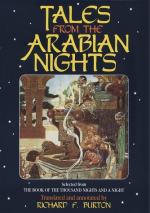[FN#60] The word has been used in this tale with a threefold sense Egypt, old Cairo (Fostat) and new Cairo, in fact to the land and to its capital for the time being.
[FN#61] Arab. “Kabbaltu” = I have accepted, i.e., I accept emphatically. Arabs use this form in sundry social transactions, such as marriages, sales, contracts, bargains, and so forth, to denote that the engagement is irrevocable and that no change can be made. De Sacy neglected to note this in his Grammar, but explains it in his Chrestomathy (i. 44, 53), and rightly adds that the use of this energetic form peut-etre serait susceptible d’applications plus etendues.
[FN#62] La nuit de l’entree, say the French: see Lane “Leylet ed-dukhlah” (M.E. chapt. vi.).
[FN#63] This Ms. uses “Milah” (pleasant) for “Mubah” (permitted). I must remark, before parting with Zayn al-Asnam, that its object is to inculcate that the price of a good wife is “far above rubies” (Prov. xxxi. 10: see the rest of this fine chapter), a virtuous woman being “a crown to her husband” (ibid. xxii. 4); and “a prudent wife is from the Lord” (Prov. xix. 4). The whole tale is told with extreme delicacy and the want of roughness and energy suggests a European origin.
[FN#64] i.e. the “Height or Glory (’Ala) of the Faith (al-Din)” pron. Alaaddeen; which is fairly represented by the old form “Aladdin;” and better by De Sacy’s “Ala-eddin.” The name has occurred in The Nights, vol. iv. 29-33; it is a household word in England and who has not heard of THomas Hood’s “A-lad-in?” Easterns write it in five different ways and in the Paris Ms. it is invariably “’Ali al-din,” which is a palpable mistake. The others are (1) ’Ala al-Din, (2) ’Ala yadin, (3) ’Alah Din in the H. V. and (4) ’Alaa al-Din (with the Hamzah), the last only being grammatical. In Galland the Histoire de la Lampe merveilleuse is preceded by the Histoire du Dormeur Eveille which, being “The Story of Abu al-Hasan the Wag, or the Sleeper awakened,” of the Bresl. Edit. (Nights cclxxi.-ccxc.), is here omitted. The Alaeddin Story exists in germ in Tale ii. of the “Dravidian Nights Entertainments,” (Madana Kamara-Sankadaj), by Pandit S. M. Natisa Shastri (Madras, 1868, and London, Trubner). We are told by Mr. Coote that it is well represented in Italy. The Messina version is by Pitte, “La Lanterna Magica,” also the Palermitan “Lanterne;” it is “Il Matrimonio di Cajussi” of Rome (R. H. Busk’s Folk-lore); “Il Gallo e il Mago,” of Visentini’s “Fiabe Mantovane,” and the “Pesciolino,” and “Il Contadino che aveva tre Figli,” of Imbriana. In “La Fanciulla c il Mago,” of De Gubernatis ("Novelline di Sante Stefano de Calcenaja,” p. 47), occurs the popular incident of the original. “The Magician was not a magician for nothing. He feigned to be a hawker and fared through the streets, crying out, ’Donne, donne, chi baratta anelli di ferro contra anelli di argento?’”
Alaeddin has ever been a favourite with the stage. Early in the present century it was introduced to the Parisian opera by M. Etienne, to the Feydeau by Theaulon’s La Clochette: to the Gymnase by La Petite-Lampe of M. Scribe and Melesville, and to teh Panorama Dramatique by mm. Merle, Cartouche and Saintine (Gauttier, vii. 380).




